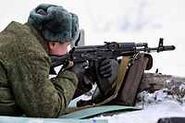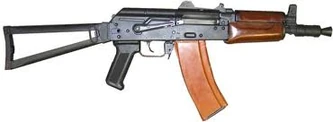
The AK-74 (Russian: Автомат Калашникова образца 1974 года or "Kalashnikov automatic rifle model 1974") is an assault rifle developed in the early 1970s in the Soviet Union as the replacement for the earlier AKM (itself a refined version of the AK-47). It uses a smaller intermediate cartridge, the 5.45x39mm, replacing the 7.62x39mm chambering of earlier Kalashnikov-pattern weapons.
The rifle first saw service with Soviet forces engaged in the 1979 Afghanistan conflict. Presently, the rifle continues to be used by the majority of countries of the former USSR. Additionally, licensed copies were produced in Bulgaria (AK-74 and AKS-74U), the former East Germany (MPi-AK-74N, MPi-AKS-74N, MPi-AKS-74NK) and Romania (PA md. 86). Besides former Soviet republics and eastern European countries, Mongolia, North Korean Special Forces, and Vietnamese People's Naval infantry use AK-74s.
History[]
The head of the Afghan bureau of the Pakistani Inter-Services Intelligence claimed that the CIA paid $5,000 for the first AK-74 captured by the mujahadeen during the Soviet war in Afghanistan.
Design details[]
The AK-74 is an adaptation of the 7.62mm AKM assault rifle and features several important design improvements. These modifications were primarily the result of converting the rifle to the intermediate-caliber 5.45x39mm cartridge, in fact, some early models are reported to have been converted AKMs, with the barrel re-sleeved to 5.45×39mm. The result is a more accurate and reliable rifle than the AKM. The AK-74 and AKM share an approximate 50% parts commonality (interchangeable most often are pins, springs and screws).
Operating mechanism][]
The rifle’s operation during firing and reloading is identical to that of the AKM. After ignition of the cartridge primer and propellant, rapidly expanding exhaust gases are diverted into the gas cylinder above the barrel through a vent near the muzzle. The build-up of gases inside the gas cylinder drives the long-stroke piston and bolt carrier rearward and a cam guide machined into the underside of the bolt carrier along with an ejector spur on the bolt carrier rail guide, rotates the bolt approximately 35° and unlocks it from the barrel extension via a camming pin on the bolt. The moving assembly has about 5.5 mm (0.2 in) of free travel which creates a delay between the initial recoil impulse of the piston and the bolt unlocking sequence, allowing gas pressures to drop to a safe level before the seal between the chamber and the bolt is broken. Like previous Kalashnikov-pattern rifles, the AK-74 does not have a gas valve; excess gases are ventilated through a series of radial ports in the gas cylinder. Since the Kalashnikov operating system offers no primary extraction upon bolt rotation, the AK-74 bolt has a larger extractor claw than the 7.62mm AKM for increased extraction reliability. Other minor modifications were made to the bolt and carrier assembly.
Barrel[]
The rifle received a new barrel with a chrome-lined bore and 4 right-hand grooves at a 200 mm (1:8 in) rifling twist rate. The front sight base and gas block were redesigned. The gas block contains a gas channel that is installed at a 90° angle in relation to the bore axis. A pair of support brackets are cast into the gas block assembly and are used to attach a BG-15 or GP-25 under-slung 40 mm grenade launcher. The forward section of the front sight base features a threaded collar that is used to screw in a newly-designed multifunction muzzle device (performing the role of a muzzle brake, recoil compensator and flash suppressor) or a blank-firing adaptor. The muzzle device is held in place by a spring-loaded button and is quickly detachable. The distinctive muzzle brake features a large expansion chamber, two symmetrical vertical cuts at the forward end of the brake and three vent holes positioned to prevent muzzle climb and lateral shift to the right (for right-handed shooters). A flat plate near the end of the brake produces a forward thrust when emerging exhaust gases strike its surface, eliminating nearly all felt recoil. The muzzle brake prevents backblast from reaching the firer, although it is reported to be harsh on bystanders as the muzzle gases are dispersed to the sides.
New features[]
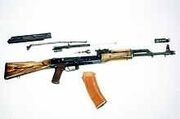
The AK-74 stripped down to its major components.
The AK-74 was equipped with a new stock, handguard (which retained the AKM-type finger swells) and gas cylinder. The stock has a different shoulder pad than the AKM, which is rubber and serrated for improved grip. In addition, there are weight-reducing lightening cuts on each side of the buttstock. The stock, lower handguard and upper heatguard were first manufactured from laminated wood, this later changed to a synthetic plum and then a black-colored polymer.
The AK-74 gas tube has a spring washer attached to its rear end designed to retain the gas tube more securely. The lower handguard is fitted with a leaf spring that reduces play in the rifle's lateral axis by keeping the wood tensioned between the receiver and the handguard retainer. The receiver remains nearly identical to that of the AKM; it is a 1 mm (0.04 in) thick sheet steel pressing supported extensively by pins and rivets. The internal guide rails on which the bolt carrier travels are stamped and spot welded to the inside of the receiver housing. Minor changes were made to the front barrel and rear stock trunnions as well as the magazine well. All external metal surfaces are coated with a glossy black enamel.
Magazines[]
The original AK-74 magazine was identical to that of the AKM, except for minor dimensional changes required by the 5.45×39mm cartridge. These rust-colored magazines are often mistakenly identified as being made of Bakelite (a phenolic resin), but were actually fabricated from a two-part glass-reinforced polyethylene plastic molding, assembled using an epoxy resin adhesive. Noted for their durability, the magazines did however compromise the rifle's camouflage. A new steel-reinforced dark-brown (newer magazines are black) 30-round magazine was introduced in the early 1980s, composed of ABS plastic. All AK-74 magazines have a raised horizontal rib on each side of the rear lug to prevent their use in a 7.62×39mm AK. The magazines can be quickly recharged from stripper clips. The empty weight of a 30-round AK-74 box magazine is 230 g (8.1 oz). The 45-round plastic box magazine of the RPK-74 light machine gun are also interchangeable with that of the AK-74.
The transition to mainly plastic magazines and the relatively small sized, light weight, high velocity 5.45×39mm cartridge yielded a significant weight reduction and allow a soldier to carry considerably more rounds for the same weight compared to the previous Soviet AK-47 and AKM and later 7.62x39mm chambered AK platform assault rifles.
North Korea has developed an ultra-high capacity magazine for bodyguards of Kim Jong-un. Photos show a large helical magazine, believed to contain between 75 and 150 rounds, attached to domestically-produced Type 88 or Type 98 rifles.
| Rifle | Cartridge | Cartridge weight | Weight of loaded magazine | Max. 5,510 g (12.1 lb) ammunition load |
|---|---|---|---|---|
| AK-47 (1949) | 7.62×39mm | 16.3 g (252 gr) | 30-round magazine @ 916 g (32.3 oz) | 6 magazines @ 5,496 g (12.12 lb) for 180 rounds |
| AKM (1957) | 7.62×39mm | 16.3 g (252 gr) | 30-round magazine @ 819 g (28.9 oz) | 6 magazines @ 4,914 g (10.83 lb) for 180 rounds |
| AK-103 (1994) | 7.62×39mm | 16.3 g (252 gr) | 30-round magazine @ 739 g (26.1 oz) | 7 magazines @ 5,173 g (11.40 lb) for 210 rounds |
| AK-74 (1974) | 5.45×39mm | 10.7 g (165 gr) | 30-round magazine @ 551 g (19.4 oz) | 10 magazines @ 5,510 g (12.1 lb) for 300 rounds |
Note: The 1949 pattern slab-sided steel AK-47 30-round 7.62×39mm box magazines had an empty weight of 430 g (15 oz). The 1957 pattern steel AKM magazines had lighter sheet-metal bodies with prominent reinforcing ribs weighing 330 g (12 oz). The current issue 7.62×39mm 30-round magazines have an empty weight of 250 g (8.8 oz) are backwards compatible to the older 7.62×39mm AK assault rifle variants and are made of steel-reinforced plastic similar to the AK-74 magazines.
Accessories[]
Accessories supplied with the rifle include a 6H4 or 6H5 type bayonet, a quick-loading device, three spare magazines, four 15-round stripper clips, maintenance kit, cleaning rod and sling. The bayonet is installed by slipping the muzzle ring around the flash hider and latching the handle down on the bayonet lug under the front sight base. The rifle fires the intermediate 5.45×39mm M74 rifle ammunition that includes the jacketed, steel-core 7N6 bullet, 7T3 tracer round and a blank cartridge. The ammunition was developed by a team of designers led by Victor Sabelnikov.
Variants[]
AKS-74[]

The AKS-74. Designed for airborne infantry and equipped with a folding shoulder stock.
The AKS-74 ("S" – Russian: складной; Skladnoy, or "folding"), is a variant of the AK-74 equipped with a side-folding metal shoulder stock, designed primarily for use with air assault infantry and developed alongside the basic AK-74. Unlike the AKMS's somewhat fragile underfolding stock (modeled after the MP 40 submachine gun stock), the AKS-74 stock is fabricated from
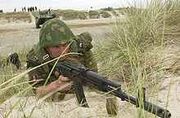
A Russian marine on exercise with the AKS-74 variant with plum polymer furniture.
stamped sheet metal struts, machine pressed into a "U" shape and assembled by punch fit and welding. The stock has a triangular shape; it lacks the folding shoulder pad found on the AKMS stock and is folded to the left side of the receiver. The hinged stock is securely locked in its extended position by a spring-loaded button catch located at the rear of the receiver. When folded, the stock is held closed by a spring-loaded capture hook situated on the left side at the front of the receiver housing. A rear-mounted sling swivel is also provided on the right side at the beginning of the stock frame.
AKS-74U[]
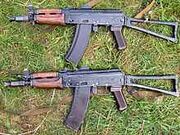
A pair of AKS-74U carbines
By Soviet TTT (тактико-технические требования) order number 008407 from 19.17.1973 a design competition (codenamed "Modern" - Модерн) was started for the adoption of a fully automatic carbine, no doubt inspired by observing the US experience in Vietnam with the XM177. The Soviet planners also drew from the unsolicited design AO-46 built in 1969 by Peter Andreevich Tkachev, which weighted only 1.9 Kg. The TTT specifications required a weight no greater than 2.2 Kg, a length of 75/45 cm with the sock folded/unfolded, and a muzzle velocity of at least 700 m/s. The competition was joined by designs of M.T. Kalashnikov (PP1), I.Y. Stechkin (TKB-0116), S.G. Simonov (AG-043), A.S. Konstantinov (AEK-958), and E.F. Dragunov (who called his model "MA"). Kalashnikov also presented an additional design (A1-75) which differed from PP1 by having a modified muzzle for flash and noise suppression. By 1977 the GRAU decided to adopt Kalashnikov's model, which was largely a shortened AKS-74, because it was no worse than the competition in terms of performance and promised significant production cost savings by utilizing existing equipment for the AK-74 line. A final round of large scale testing with Kalashinkov's model was performed by airborne divisions in the Transcaucasian Military District in March 1977. The AKS-74U ("U" — Russian: укороченный; Ukorochenniy, or "shortened") was officially adopted in 1979, and given the official, but seldom used GRAU designation 6P26.

A Ukrainian Marine displaying an AKS-74U.
In terms of tactical deployment, the AKS-74U bridges the gap between a submachine gun and an assault rifle. It was intended for use mainly with special forces, airborne infantry, rear-echelon support units and armored vehicle crews. It is still used in these roles, but has been augmented by various submachine guns, and the AK-105. It is also commonly used by law enforcement; for example, each urban police foot patrol is issued at least one.
The rifle's compact dimensions, compared to the AKS-74, were achieved by using a short 210 mm (8.3 in) barrel (this forced designers to simultaneously reduce the gas piston operating rod to an appropriate length). In order to effectively stabilize projectiles, the barrel’s twist rate was increased from 200 mm (1:8 in) to 160 mm (1:6.3 in) to adapt the AKS-74U for muzzle velocities of 720 m/s (2,362 ft/s) and higher. A new gas block was installed at the muzzle end of the barrel with a new conical flash hider combined with a cylindrical muzzle booster, which features an internal expansion chamber that increases the weapon's reliability. The booster supplies an increased amount of residual gas from the barrel for the gas system. The chrome-lined muzzle booster also burns any remaining propellant thus reducing the gun's signature. The muzzle device locks into the gas block with a spring-loaded detent and features two notches cut into the flash hider cone, used for disassembly using the supplied cleaning rod. The forward sling loop was relocated to the left side of the carbine and the front sight was integrated into the gas block.
The AKS-74U also has a different sighting system with a U-shaped flip sight instead of the standard sliding notch rear sight. This sight has two settings: "P" (calibrated for firing at 350 m) and "4–5" (used for firing at distances between 400–500 m). The rear sight is housed in a semi-shrouded protective enclosure that is riveted to the receiver's top cover. This top cover is integral with the gas tube cover and hinged from the barrel trunnion, pivoting forward when opened. Both the gas tube and handguard are also of a new type and are shorter than the analogous parts in the AKS-74.
The AKS-74U is significantly more maneuverable in tight quarters than the AKS-74; however, the significant decline in muzzle velocity from 900 m/s (2,953 ft/s) to 735 m/s (2,411 ft/s) resulted in a decrease in effective range (the effective hitting distance for a "running"-type silhouette target was reduced from 625 m (684 yd) to 350 m (383 yd). The carbine cannot mount a bayonet or standard under-barrel grenade launcher. However, a suppressed 30 mm BS-1 grenade launcher was developed specifically for that platform that fires a high-explosive dual purpose (HEDP) grenade. The grenades for the BS-1 are launched by special blank cartridges that are inserted into the grenade launcher via a detachable magazine. The majority of AKS-74U carbines were manufactured at the Tula Arms Factory rather than Izhmash. The AKS-74U was also used as the basis for several other unique weapons, including the bullpup OTs-14 Groza specialist carbine, and the Gepard series of multi-caliber submachine guns (none of which evolved past prototype stage).
In the United States, the AKS-74U is called a "Krinkov". The origin of this term is uncertain. A theory was circulating that the name came from the mujahadeen who supposedly had captured a high-ranking Soviet officer armed with an AKS-74U, and that they had named it after him. However, investigation by Patrick Sweeney could not confirm this theory, for no Soviet officer with a resembling name was captured in Afghanistan. US journalist C. J. Chivers reported that the gun was nicknamed "the Osama" in Jihadist circles, after Osama bin Laden was photographed next to an AKS-74U.
Specialized variants[]
The AK-74 is also available in several "night-fighting" configurations, equipped with a side-rail used to mount night vision sights (these variants, the AK-74N, AKS-74N and AKS-74UN are used in conjunction with NSPU and NSPUM sights). The AKS-74UB ("B" — Russian: бесшумный; Besshumniy or "silent") is a sound-suppressed variant of the AKS-74U adapted for use with the PBS-4 suppressor (used in combination with subsonic 5.45×39mm Russian ammunition). Very little is known about this model.
AK-74M[]

AK-74M
In 1991 the Izhmash factory in the city of Izhevsk began full scale production of a modernized variant of the AK-74 – the AK-74M (M – Russian: Модернизированный; Modernizirovanniy or "modernized") assault rifle that offers more versatility compared to its predecessor. Apart from several minor production improvements, such as a lightened bolt and carrier assembly, the rifle features a new synthetic stock made from a black, glass-filled polyamide that is shaped like the AK-74 fixed stock, but also side-folds like in the AKS-74. Additionally the AK-74M uses an improved muzzle device and reinforced smooth dust cover. Each AK-74M is fitted with a side-rail bracket for mounting optics. The AK-74M would have been adopted by the Soviet Union as the standard service rifle, and has been accepted as the new service rifle of the Russian Federation with some AK-74Ms featuring a Picatinny rail for easier mounting of optics.
AK-100 series[]

AK-12
The AK-74 was also the basis for the new Russian family of Kalashnikov firearms: the 5.56 mm AK-101 standard rifle and 5.56 mm AK-102 carbine (both use the NATO-standard 5.56×45mm cartridge), 7.62 mm AK-103 assault rifle and 7.62 mm AK-104 (both chambered for the 7.62×39mm M43 round) and the 5.45 mm AK-105 carbine (adapted to use 5.45×39mm M74 ammunition). The AK-101, 102, 103 and 104 are destined primarily for export, while the AK-105 is slated to replace the AKS-74U with the Russian Armed Forces. Additionally, the AK-107 (5.45×39mm M74) and AK-108 (5.56×45mm NATO) rifles have a balanced recoil system to reduce felt recoil and muzzle rise. This balanced recoil system is derived from the AEK-971 rifle. In 2010 a new variant, the AK-12 series, was unveiled. It differs in weight and has enhanced modularity.



